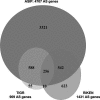Genomewide comparative analysis of alternative splicing in plants
- PMID: 16632598
- PMCID: PMC1459036
- DOI: 10.1073/pnas.0602039103
Genomewide comparative analysis of alternative splicing in plants
Abstract
Alternative splicing (AS) has been extensively studied in mammalian systems but much less in plants. Here we report AS events deduced from EST/cDNA analysis in two model plants: Arabidopsis and rice. In Arabidopsis, 4,707 (21.8%) of the genes with EST/cDNA evidence show 8,264 AS events. Approximately 56% of these events are intron retention (IntronR), and only 8% are exon skipping. In rice, 6,568 (21.2%) of the expressed genes display 14,542 AS events, of which 53.5% are IntronR and 13.8% are exon skipping. The consistent high frequency of IntronR suggests prevalence of splice site recognition by intron definition in plants. Different AS events within a given gene occur, for the most part, independently. In total, 36-43% of the AS events produce transcripts that would be targets of the non-sense-mediated decay pathway, if that pathway were to operate in plants as in humans. Forty percent of Arabidopsis AS genes are alternatively spliced also in rice, with some examples strongly suggesting a role of the AS event as an evolutionary conserved mechanism of posttranscriptional regulation. We created a comprehensive web-interfaced database to compile and visualize the evidence for alternative splicing in plants (Alternative Splicing in Plants, available at www.plantgdb.org/ASIP).
Conflict of interest statement
Conflict of interest statement: No conflicts declared.
Figures


References
-
- Stamm S., Ben-Ari S., Rafalska I., Tang Y., Zhang Z., Toiber D., Thanaraj T. A., Soreq H. Gene. 2005;344:1–20. - PubMed
-
- Lareau L. F., Green R. E., Bhatnagar R. S., Brenner S. E. Curr. Opin. Struct. Biol. 2004;14:273–282. - PubMed
-
- Black D. L. Annu. Rev. Biochem. 2003;72:291–336. - PubMed
-
- Gupta S., Zink D., Korn B., Vingron M., Haas S. A. Bioinformatics. 2004;20:2579–2585. - PubMed
Publication types
MeSH terms
LinkOut - more resources
Full Text Sources
Other Literature Sources
Molecular Biology Databases
Research Materials

